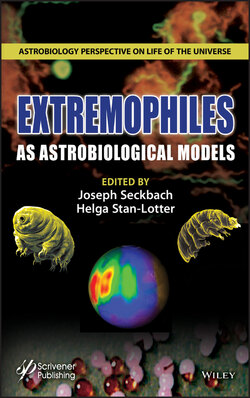Читать книгу EXTREMOPHILES as Astrobiological Models - Группа авторов - Страница 22
1.3.1 Steam Collection
ОглавлениеSamples of steam were collected from fumaroles in four permanently protected geothermal areas, Lassen Volcanic National Park, Hawai’i Volcanoes National Park, Valles Caldera National Preserve, and Solfatara Crater, Italy. Our steam collector (Figure 1.1) consists of a stainless shroud with a central holder for the sample tube. The condenser with a splash shield fits into the shroud and is slightly raised at 3 points, allowing excess steam to bypass the edges of the condenser during collection. The central lower guide rod directs condensed steam water into a sterile 50 mL polypropylene tube. During steam collection the open tube rests in a holder attached near the bottom of the shroud. The steam condenser can be handheld, but is also used attached to a tripod by an external mount, which by design serves to protect samples from aerial contaminants. During collection, rising steam contacts the water-cooled condenser and the guide rod drains the condensed steam water directly into the collection tube. After collection, the tube is immediately capped. Overall, the unit is portable, durable, corrosion resistant, easily autoclaved and produces contamination-free steam condensed samples and controls in a relatively short time period. In an average collection a 20–25 mL sample is collected in 15 min. Faster collections occur with a high steam flow rate and elevated temperature. These range between 1–3 mL min-1 in extreme fumaroles near or above 90 °C; examples of those are found in Lassen Volcanic National Park [1.8].
We found that collected steam water carried with it organisms that were detected microscopically when stained with DAPI (a dsDNA stain) and examined by fluorescence microscopy. Ellis et al. [1.8] found organisms in steam from volcanic fumaroles collected at several widely distant geothermal regions: Kamchatka, Russia, Lassen Volcanic National Park, Yellowstone National Park, Sulphur Springs, New Mexico, Valles Caldera National Preserve and Hawai’i Volcanoes National Park. The steam collector was small enough to transport sterile collectors by airplane. The efficiency of collection allowed the collector to be easily used under most field conditions. We were able to estimate cell numbers and found the efficiency of the collector improved with collection from high temperature, low pH steam vents. DAPI staining and phase contrast microscopy showed that steam from all vents examined contained cells. We were able to estimate cell concentrations in steam water, extract DNA for PCR and cloning and isolate Archaea from enrichments and from subcultures. Concentrations ranged from a low value of 150 cells ml-1 in Kamchatka, Russia, to a high number of 1100 cells ml-1 in Lassen Volcanic National Park SW2, a sulfur vent. Microscopic observations revealed that Hawaiian fumaroles contained several morphological types and the greatest diversity of phylotypes of any fumaroles examined. By applying lab collection rates in controlled experiments, we found that the collector efficiency was almost 14%, and the flow rate of one Yellowstone fumarole was determined to be about 15 mL min-1. This allowed us to estimate a dispersal rate of 3 × 103 cells min-1 or 4 × 106 cells day-1. Hawai’i steam samples contained the greatest diversity of halophiles, isolated initially from steam vent water and later from steam deposits, and suggested that halophiles may be present in these habitats though they do not appear able to grow at elevated temperatures [1.8]. This seems to be consistent with other areas enriched with halophiles that may also experience elevated temperatures by insolation.
